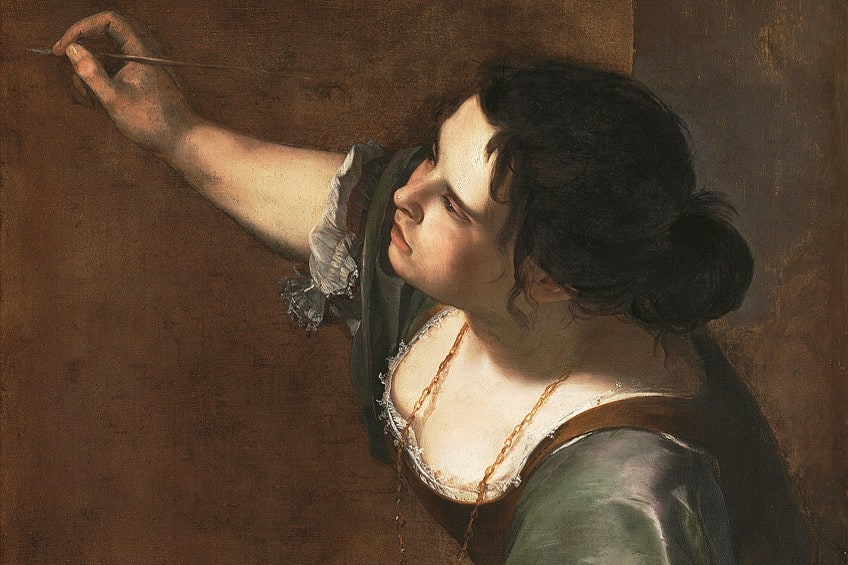Female Renaissance Artists – The Women in Renaissance Art
The affluent Renaissance women of Italy were presented with only two potential futures – join a convent or get married. This, obviously, was not the ideal environment for the nurturing of female Renaissance artists. At that time, women in Renaissance art were rare, except of course, for all the Renaissance paintings of women created by male artists. Although the idea of a Renaissance woman painting for a living was not a hugely popular one, it was not totally unheard of, and today, we will look at those exceptional examples of notable female Renaissance artists.
Our List of Notable Female Renaissance Artists
The women in Renaissance art were often taught by their fathers or were self-taught, as receiving formal training in art was often impossible. Female Renaissance paintings were often overlooked just because they were not created by a man. There was a common belief that men were better at creating a Renaissance woman portrait than women themselves. Yet, many female Renaissance paintings reveal that women have an intrinsic understanding of the nature of their gender that men lack.
Nevertheless, against all these obstacles, a number of determined and talented female Renaissance artists fought against the male-dominated world of art and took their place among the other Masters of their era.
Levina Teerlinc (1510 – 1576)
| Full Name | Levina Teerlinc |
| Nationality | Flemish |
| Date of Birth | c. 1510s |
| Date of Death | 23 June 1576 |
| Place of Birth | Bruges, Belgium |
| Notable Artworks | ● Mary with Figures in Landscape, Michaelmas (1553) ● Indenture between the Queen and the Dean and Canons of St. George’s Chapel (1559) ● The Black and White Miniature (1576) |
Born in Bruges around 1520, Levina Teerlinc was schooled by her father, Simon Bening, who was a successful miniature painter and illuminated manuscript illustrator. Both used delicate brushes, generally made of squirrel hair, and watercolor, occasionally thickened with gum Arabic. Some of her portraits were stabilized with a playing card backing and were placed in intricate boxes or lockets with lids to be safeguarded and kept secret as a concealed necklace or brooch.
Teerlinc is a mysterious person in English history since she never signed her works, but she created miniatures to be beautiful and extremely human glances into the private life of Tudors, behind the changes in the royal court during a turbulent era in English history.
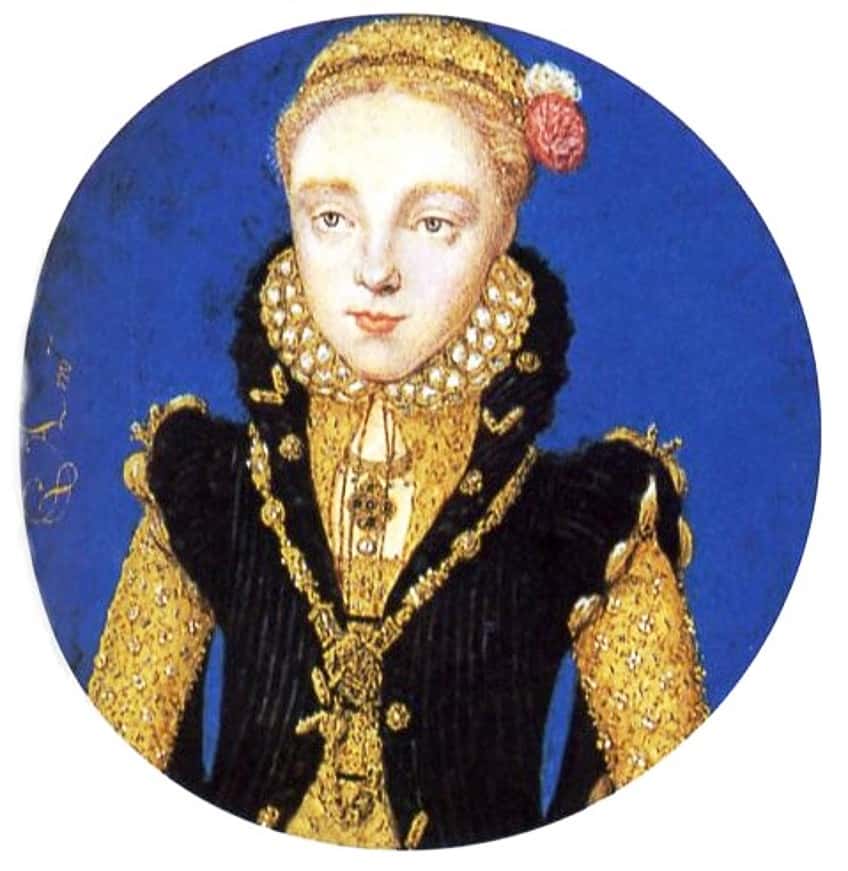
Some of these beautiful miniatures would have been hidden love mementos and not displayed publicly. As a result, historians believe that many of Teerlinc’s miniatures may have been mistakenly assigned to other painters. After relocating to England, she was engaged as a royal artist by King Henry VIII, playing an important role in the emergence of the portrait miniature.
While she seldom signed her works, her recorded efforts include artworks sent to the sovereign as New Year’s gifts.
Plautilla Nelli (1524 – 1588)
| Full Name | Plautilla Nelli |
| Nationality | Italian |
| Date of Birth | c. 1524 |
| Date of Death | c. 1588 |
| Place of Birth | Florence, Italy |
| Notable Artworks | ● Praying Madonna (1550) ● Lamentation of Christ (1550) ● Pentecost (1554) |
Plautilla Nelli was the inspiration for the formation of Advancing Women Artists. In the 1500s, she painted in Florence, and her large-scale religious artworks are a valuable exception in history. Plautilla Nelli, a Renaissance convent artist, was Florence’s first documented female painter. Pulisena Margherita Nelli was a nun by the age of 14 in 1538, when she entered a Dominican monastery. It was located across from the San Marco monastery in Florence’s magnificent Piazza San Marco on Via Larga.
Plautilla Nelli, the daughter of a mercantile family, socialized with notable male artists of the day and was recognized for maintaining a working workshop within her order.

Plautilla Nelli was among the few female painters documented by Giorgio Vasari, and she was known to have received Fra Bartolomeo’s sketches, a notable religious artist who continued Beato Angelico’s traditions. Andrea del Sarto, Perugino, and Giovanni Antonio Sogliano all had an impact on Nelli’s work. “There were so many of her works in the residences of nobles in Florence, it would be boring to name them all”, Vasari wrote.
Scholars have recently discovered more groundbreaking attributions, bringing Plautilla Nelli’s output to about 17 pieces.
Caterina van Hemessen (1528 – 1565)
| Full Name | Catharina van Hemessen |
| Nationality | Flemish |
| Date of Birth | c. 1528 |
| Date of Death | c. 1565 |
| Place of Birth | Antwerp, Belgium |
| Notable Artworks | ● Self-Portrait (1548) ● Portret Van Een Vrouw (1548) ● Portrait of a Child (1559) |
Like a number of female Renaissance artists. Caterina van Hemessen was the daughter of an artist, Jan Sanders van Hemessen, who was presumably her tutor. She went on to paint portraits of affluent men and women against darkened backgrounds. Her most famous work is a self-portrait she did in Basel. She signed the picture with the year 1548 and her age of 20. Her strong status in the Guild of St. Luke and subsequent role as instructor to three male students attest to her achievement.
While not a particularly masterful painter, Van Hemessen is frequently credited with producing the very first self-portrait of a painter, of either gender, sitting at an easel.
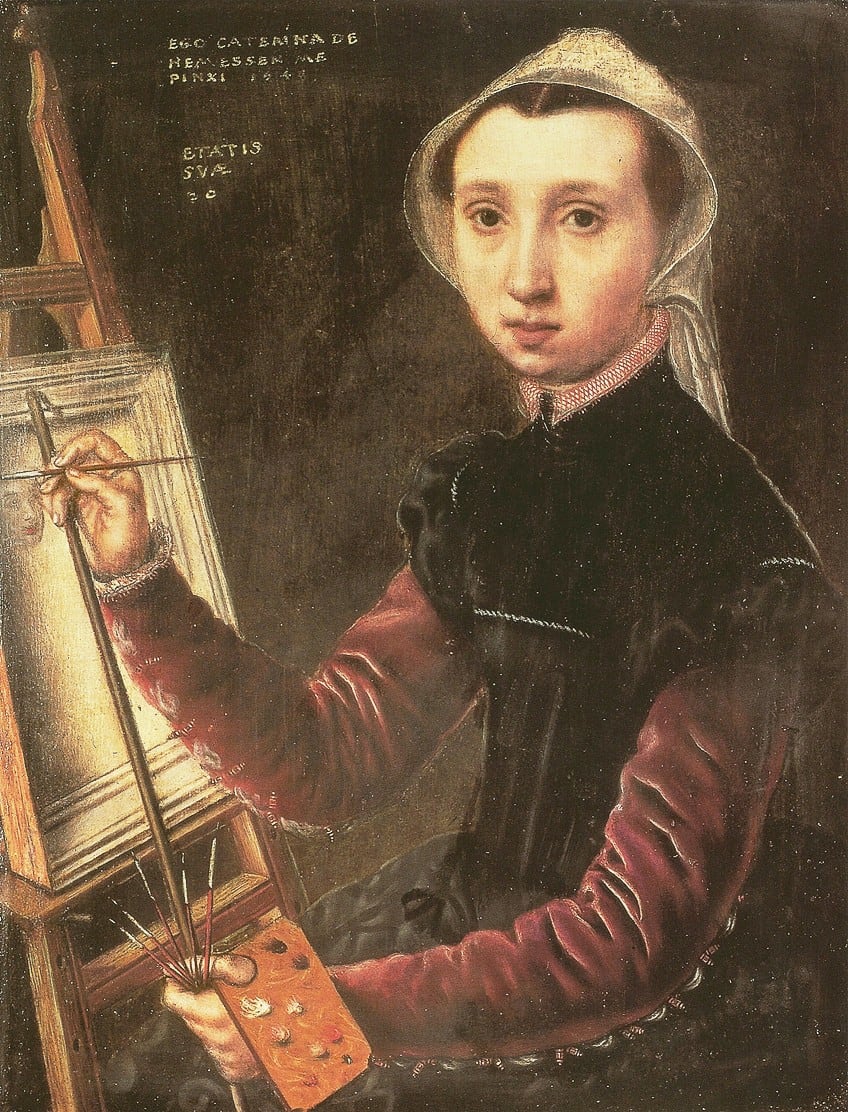
A multitude of barriers lay in the way of Renaissance women aspiring to be artists. Their instruction would include the dissection of cadavers as well as studying the naked male form, while the apprenticeship system required the prospective painter to live with an experienced artist for 4 to 5 years, generally commencing at the age of 9 to 15.
Female painters were exceedingly uncommon for these reasons, and those who did make it were often schooled by a close family member, in van Hemessen’s case, her father.
Sofonisba Anguissola (1532 – 1625)
| Full Name | Sofonisba Anguissola |
| Nationality | Italian |
| Date of Birth | c. 1532 |
| Date of Death | 16 November 1625 |
| Place of Birth | Cremona, Italy |
| Notable Artworks | ● Self-Portrait (1554) ● The Game of Chess (1555) ● Portrait of Minerva Anguissola (1564) |
Art was mostly a male vocation in the 16th century. Sofonisba Anguissola did not conform to customary duties allocated to women at that time, such as mother and housekeeper. Rather, as an independent and strong woman, she chose to pursue her dream of becoming a painter. By doing so, she cleared the path for other Renaissance women to follow in her footsteps, like Lavinia Fontana, who went on to create Renaissance paintings of women and men and historical paintings.
Anguissoa’s artworks were not restricted to the genre of the self-portrait. She proved that women were capable of making different sorts of art in the same way that some of the most prominent male painters of her period were.
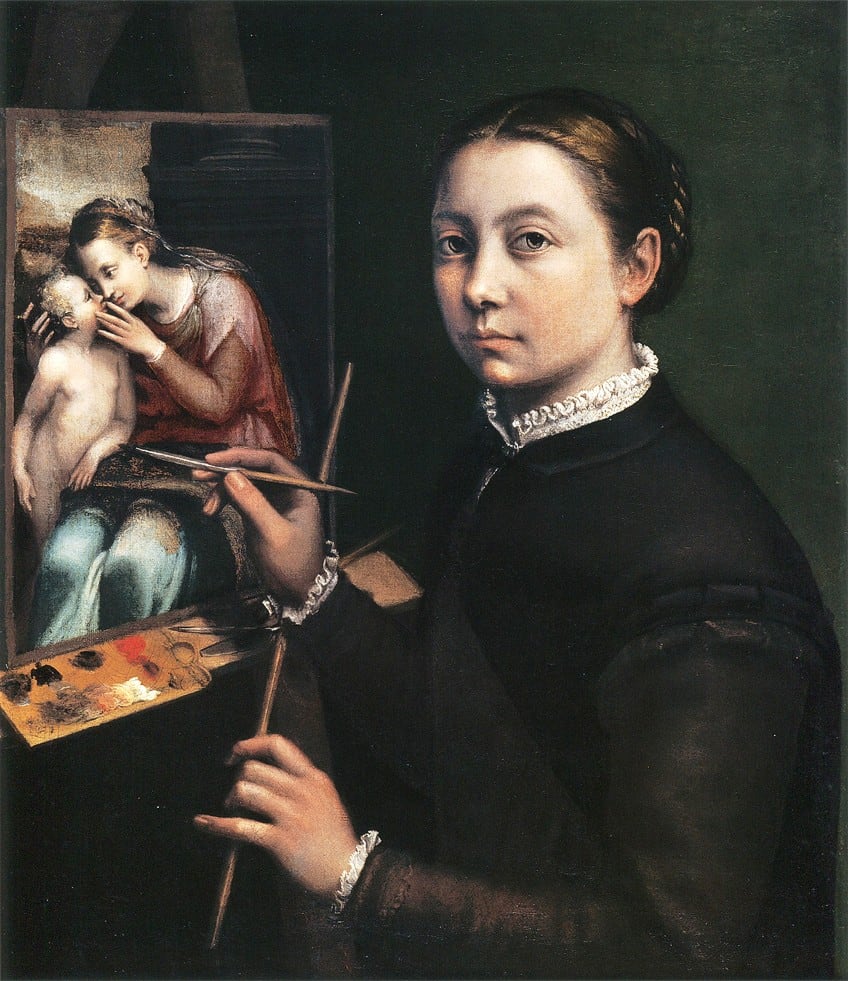
She produced portraits for Philip II’s Spanish court, for instance. She was a teacher to his wife, Queen of Spain consort Elisabeth of Valois. She managed to be both a teacher to the consort and a renowned painter at the same time. In these paintings, she asserted her status as a significant royal artist and demonstrated that her ability was on par with that of contemporaneous male court artists. However, her creative career was hampered in certain respects by her employment as a royal artist in Spain. Anguissola created these works to make a livelihood, following the terms of a restrictive contract.
Her Renaissance woman paintings, on the other hand, are evidence of her artistic independence and self-expression.
Lavinia Fontana (1552 – 1614)
| Full Name | Lavinia Fontana |
| Nationality | Italian |
| Date of Birth | 24 August 1552 |
| Date of Death | 11 August 1614 |
| Place of Birth | Bologna, Italy |
| Notable Artworks | ● Portrait of a Noblewoman (1580) ● The Holy Family with Saint Catherine of Alexandria (1581) ● Minerva Dressing (1613) |
Lavinia Fontana is largely regarded as the world’s first professional female painter. Although several female Renaissance artists existed before Fontana, none pursued art as a career. Fontana worked as a portrait artist throughout her 11 pregnancies. She eventually received major commissions from the papacy and noble families. Nonetheless, several of her most famous paintings were credited to a male artist.
Currently, art historians have recognized Fontana as one of the most significant painters of the Italian Renaissance, deserving of a permanent exhibition in the world’s most prestigious institutions.
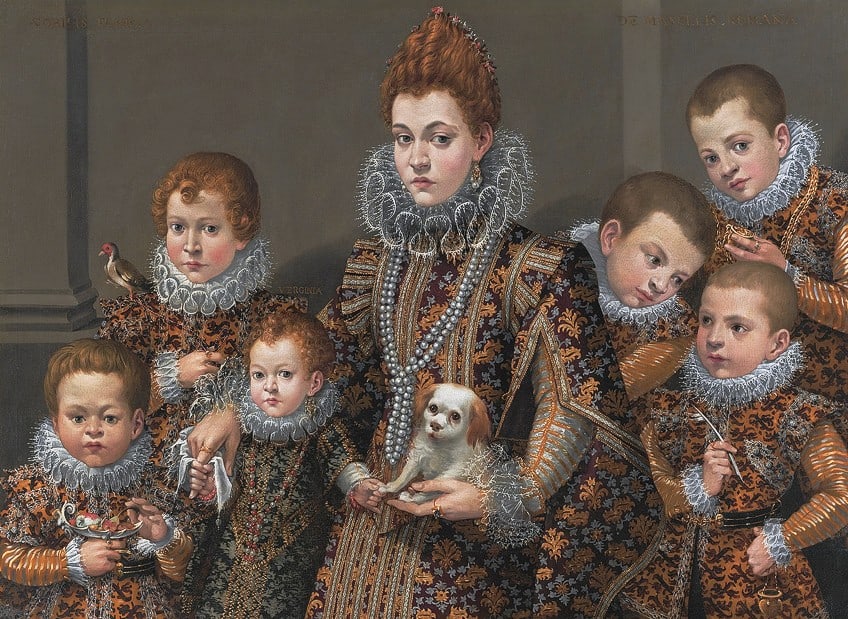
Fontana’s gender may have placed her at a disadvantage in the larger world of art, but it was unquestionably a benefit in Renaissance woman portraiture. Fontana was a warm-hearted artist whom many ladies felt more comfortable sitting for than a masculine counterpart. Some of her clients became such good friends with her that they acted as godmothers for her children. The Duchess of Sora was one such woman. Her Renaissance women paintings are comparable to those of Sofonisba Anguissola. However, because Anguissola was a noblewoman, it was not deemed right for her to be paid for her duties.
Fontana, being the daughter of an artist, paid the same pay for her Renaissance paintings of women as any male painter would.
Fede Galizia (1578 – 1630)
| Full Name | Fede Galizia |
| Nationality | Italian |
| Date of Birth | c. 1578 |
| Date of Death | c. 1630 |
| Place of Birth | Milan, Italy |
| Notable Artworks | ● Portrait of Paolo Morigia (1595) ● Judith with the Head of Holofernes (c. 1610s) ● Still Life of Cherries in a Bowl (1620) |
Galizia’s most notable and well-known works are a series of realistic still lifes, frequently of fruit viewed on a porcelain or metal tazza placed against a dark backdrop. She was a member of the Milanese movement, which was fostered by Cardinal Federico Borromeo and comprised Ambrogio Figino, Caravaggio, and Panfilo Nuvolone. As a consequence, she gained the patronage of the Milanese nobles and priests, and she is said to have been well-liked at the Palace of Rudolph II in Prague.
During her career, she produced vast scriptural scenes ordered by the anti-reformist Church under the Spanish Habsburgs, as well as portraiture and still lifes. Galizia learned her trade while working in her father’s studio, who was also an artist.
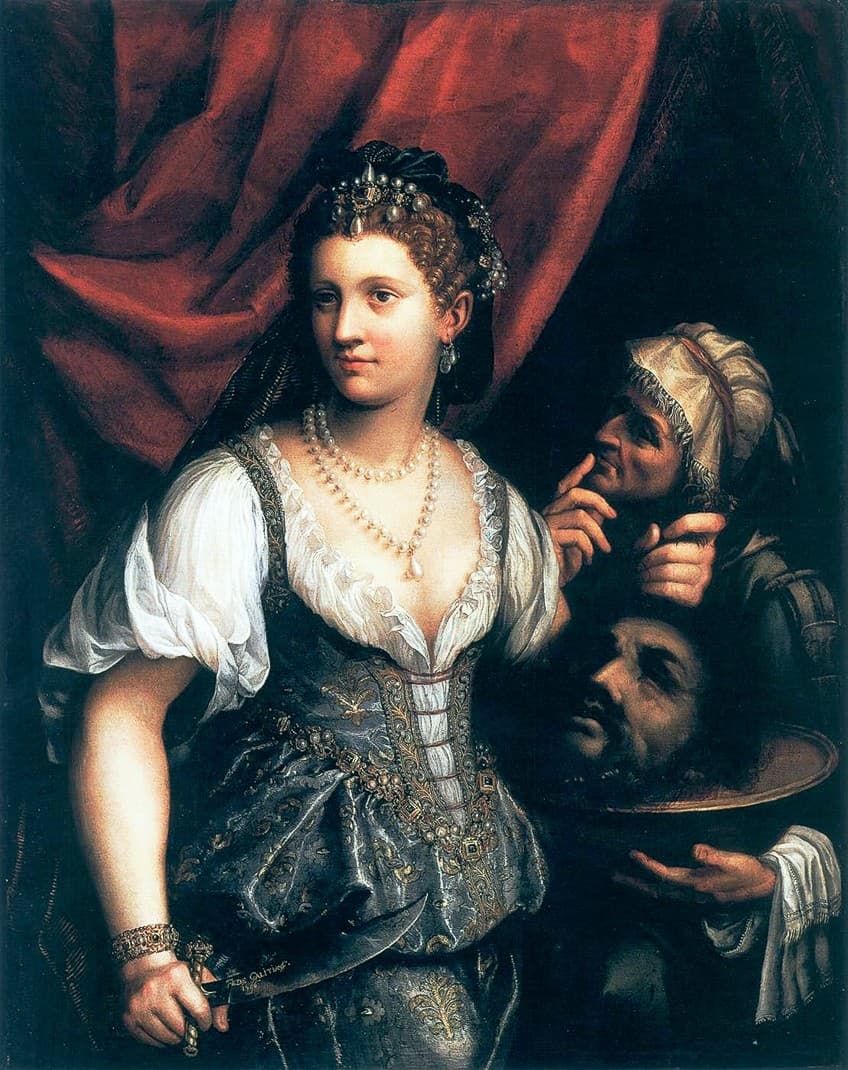
She had unusually early artistic virtuosity, prompting author Gian Paolo Lomazzo to point her out at the age of 12. Galizia’s father was a miniaturist, engraver, and designer of ceremonial clothing, and his influence can be seen throughout her works. Galizia experienced significant success from both clients and colleagues in the 1590s. In 1595, Paolo Morigia included her works in his census of renowned painters. Soon after, Giuseppe Arcimboldo took a particular interest in her painting and had it shipped to Prague for Rudolph II.
Galizia began her career producing still lifes, inspired by Vincenzo Campi, who copied and promoted Dutch genre themes in neighboring Cremona.
Artemisia Gentileschi (1593 – 1653)
| Full Name | Artemisia Gentileschi |
| Nationality | Italian |
| Date of Birth | 8 July 1593 |
| Date of Death | c. 1653 |
| Place of Birth | Rome, Italy |
| Notable Artworks | ● Susanna and the Elders (1610) ● Danae (1612) ● Jael and Sisera (1620) |
During the 17th century, Artemisia Gentileschi was Europe’s best-known female artist. She was not able to enter the conventional artistic training model as an assistant or apprentice of an established studio due to the restrictions put on women. Instead, she studied with her father, who boasted about her superior aptitude to that of her siblings. Gentileschi’s female Renaissance paintings frequently showed heroic heroines from biblical, mythical, and historical themes.
Gentileschi was the first woman to be admitted to Florence’s Accademia di Arte del Disegno and the first known woman artist to gain worldwide patronage.
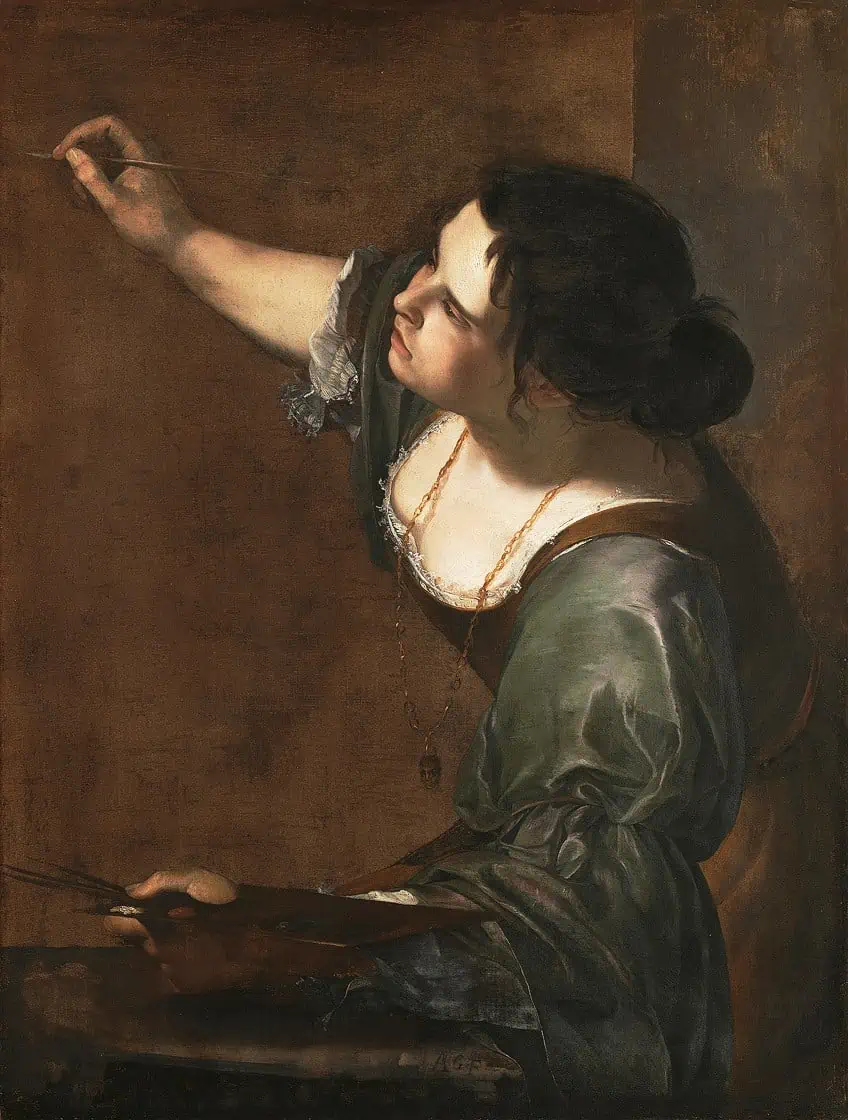
After relocating from Rome to Florence, she rapidly gained the Medicis’ favor and royal court commissions. After her divorce, she became the head of her own family, ensuring unusual freedom for women at the time and nurturing her daughters, who went on to become painters in their own right. Gentileschi is frequently referred to as a Caravagista because her father was strongly influenced by Caravaggio, though her specific abilities were unrivaled in her elegant yet dramatic handling of lighting, tapestries and her amazing ability to portray both the physical form as well as mental and emotional states of her female subjects.
Many of her Renaissance women paintings reflect familiar themes from modern art but from the often-overlooked perspective of the female victor.
Judith Leyster (1609 – 1660)
| Full Name | Judith Jans Leyster |
| Nationality | Dutch |
| Date of Birth | 28 July 1609 |
| Date of Death | 10 February 1660 |
| Place of Birth | Haarlem, Netherlands |
| Notable Artworks | ● Serenade (1629) ● The Last Drop (1629) ● The Proposition (1631) |
At the start of her career, Leyster was influenced by Caravaggio’s Utrecht followers, which can be seen in half-length portraits of cheerful performers and drinkers against a neutral backdrop, as well as the use of light and shadow contrasts. She was possibly a student of Frans Hals in 1629, and she saw the christening of one of the master’s children in 1631. Dirck Hals also had an impact on her.
Leyster was a fellow of the Haarlem guild by 1633. She had three pupils in 1635, indicating that she was a well-known artist.
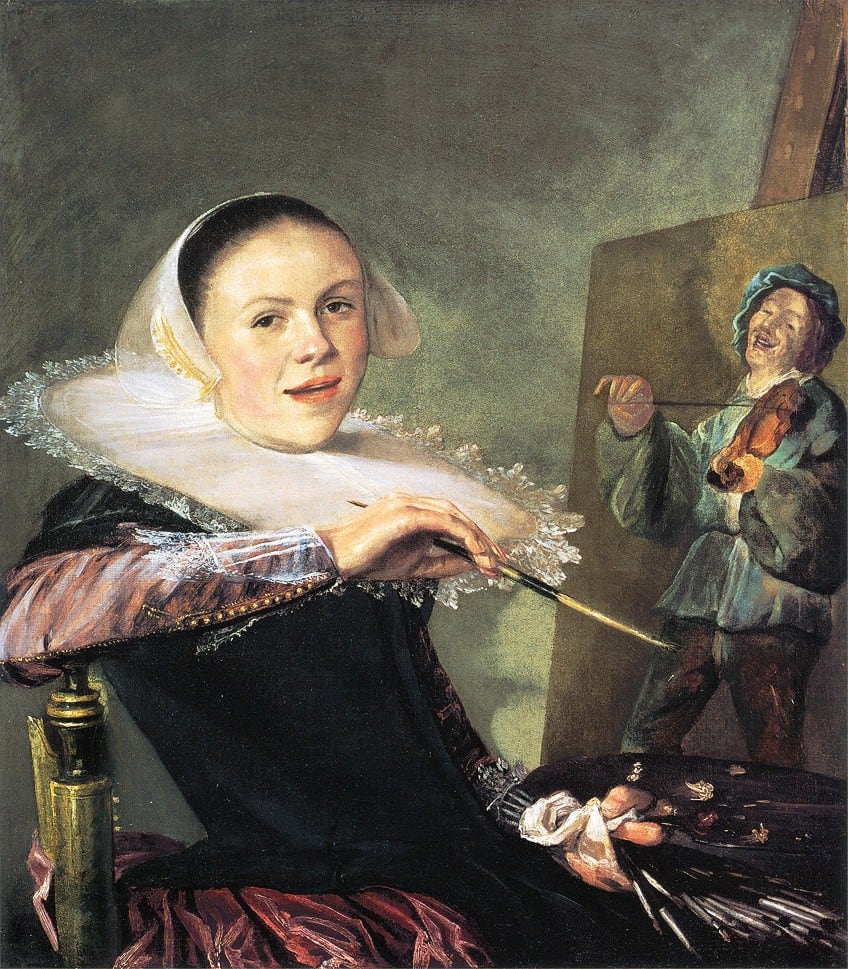
Leyster married the artist Jan Miense Molenaer (who was presumably also a disciple of Frans Hals) in 1636, and while she proceeded to paint beyond that date, few paintings of hers are known today. She was one of the Dutch Golden Age’s few professional female artists. She worked in Heemstede, Amsterdam, and Haarlem, among other places. She was mostly a genre artist, although she was also engaged in flower painting, particularly around 1635. Despite being lauded by her contemporaries and historians, Leyster has been mostly forgotten in art history since her passing in 1660.
Until Hofstede de Groot ascribed seven works to her in 1893, her whole output was assigned to Frans Hals or her husband.
Elisabetta Sirani (1638 – 1665)
| Full Name | Elisabetta Sirani |
| Nationality | Italian |
| Date of Birth | 8 January 1638 |
| Date of Death | 28 August 1665 |
| Place of Birth | Bologna, Italy |
| Notable Artworks | ● Allegory of Music (1659) ● Virgin and Child (1663) ● Portia Wounding her Thigh (1664) |
Elisabetta Sirani, a virtuoso artist, lived a brief life marked by her enormous creative skill. Elisabetta generously donated her skills and launched Europe’s first Academy for female artists. Despite her early death at the age of 27, Sirani made a significant contribution to Renaissance paintings. Elisabetta Sirani was destined to be a brilliant artist. She was raised in and around Giovanni, her father’s painting studio.
Giovanni and his wife were the parents of four children. All four showed outstanding artistic skill, but Elisabetta Sirani’s was extraordinary.
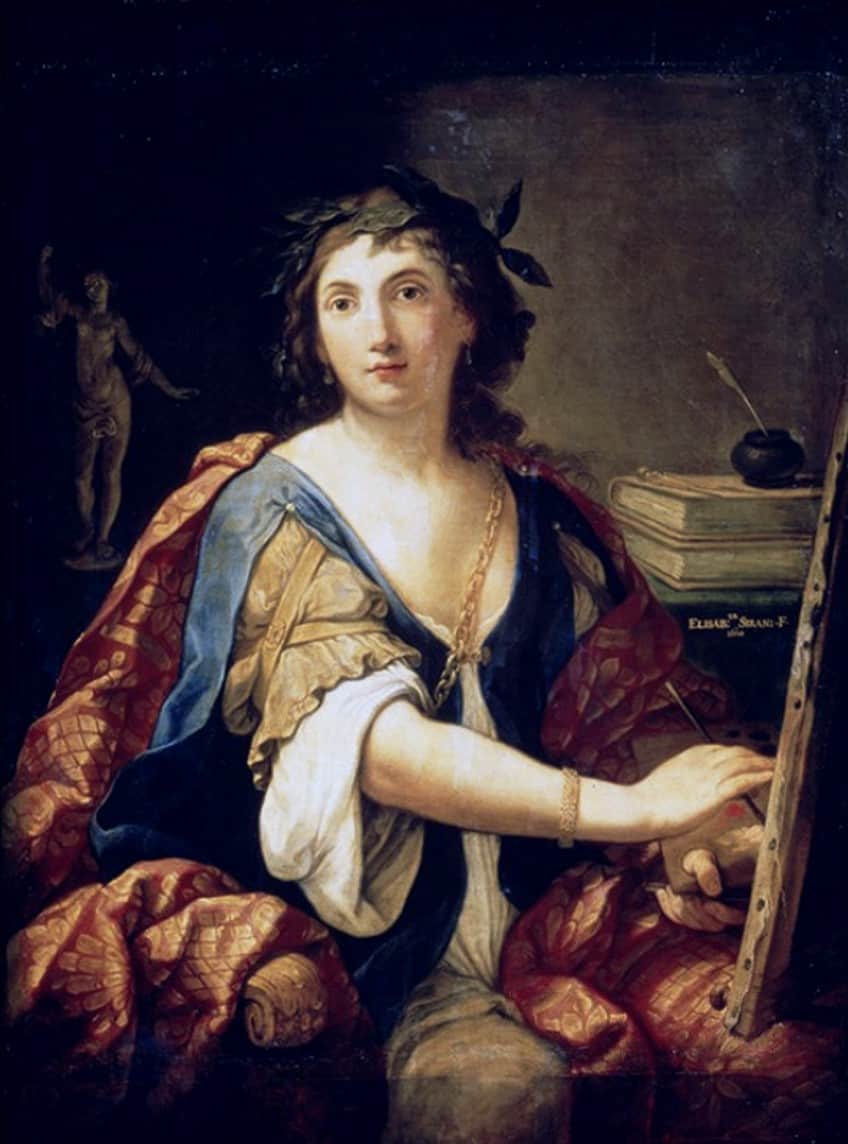
Giovanni was an artist who trained under Guido Reni at the School of Bologna. Giovanni grudgingly passed up his Bologna School education to Elisabetta Sirani. Her father’s connections with Guido Reni aided her. As her popularity rose, a Bologna artist claimed she was the female embodiment of the Baroque master. Giovanni became very ill with gout when Sirani was 16 years old. She took up the operation of her family’s workshop in addition to instructing her younger siblings and painting regularly. Sirani’s younger sisters were still too young to contribute financially to the household. As a consequence of Giovanni’s sickness, she became the primary earner for the Sirani family.
Sirani frequently opened her workshop to interested artists and admirers who marveled at her work. Her creative talent superseded those of her sisters and father due to her dedication to her work.
Rachel Ruysch (1664 – 1750)
| Full Name | Rachel Ruysch |
| Nationality | Dutch |
| Date of Birth | 3 June 1664 |
| Date of Death | 12 August 1750 |
| Place of Birth | The Hague, Netherlands |
| Notable Artworks | ● Roses, Convolvulus, Poppies, and Other Flowers in an Urn on a Stone Ledge (1688) ● Flowers in a Glass Vase (1704) ● Flower Still Life (1726) |
Ruysch grew up in an unusual, almost odd environment, which influenced her paintings, which depicted fecund flowers and somber, amphibian-speckled woodland floors. She was born in 1664 and was raised in an environment rich in both science and art. Her mother was born into a creative family; her father was Pieter Post, the Dutch imperial architect, and Frans Post, her uncle, was a well-known artist. Her father, Frederik, contributed scientific acumen to her gene pool. Frederik, too, was an art collector. He was a devotee of Otto Marseus van Schrieck, a local artist noted for his images of a genre known as sottobosco, which featured insects and fungi. When Van Schrieck died in 1678, Frederik purchased many preserved butterflies from the artist’s estate, as well as some of his works.
Growing up in such an environment encouraged Ruysch to incessantly draw flora and wildlife. Her technique was systematic, and her brushstrokes were precise and clean.
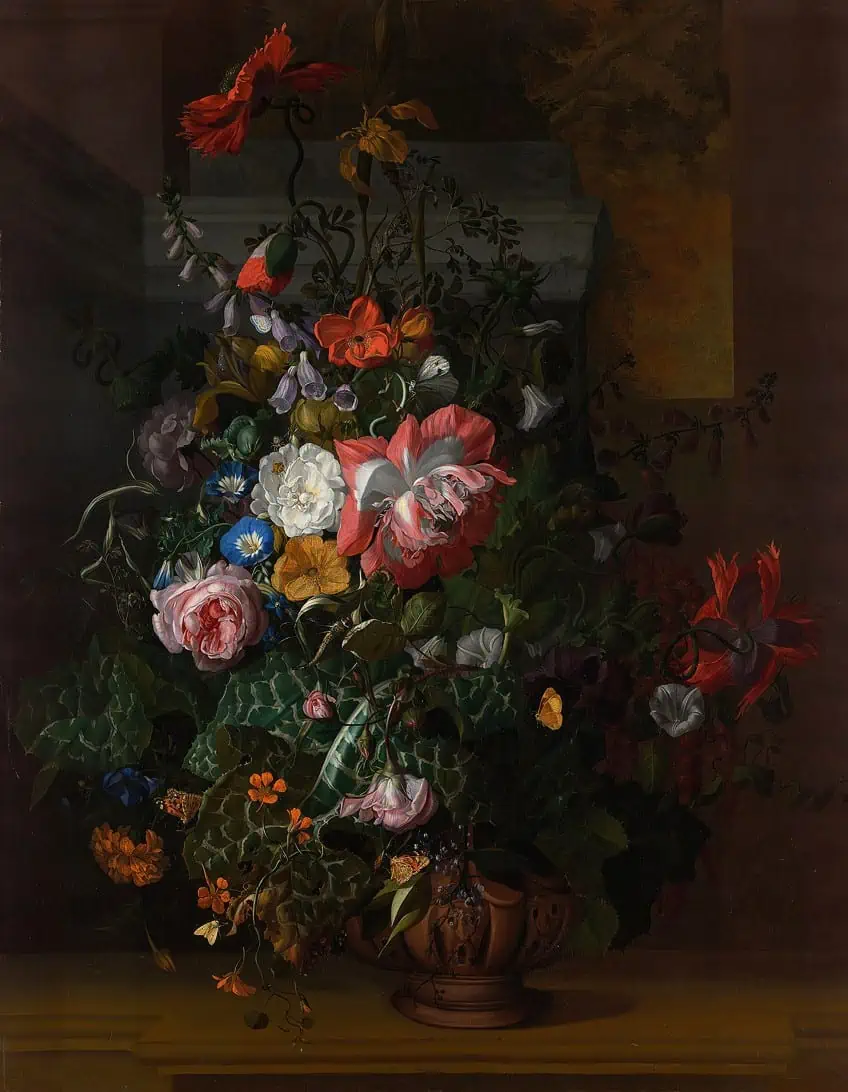
According to Luuc Kooijmans, Ruysch initially laid the overarching framework of her creations and then used fine brushes to embellish them with mesmerizing minutia: bug-bitten foliage; fragile petals; and insects with translucent wings and bodies full of patterns. She used actual moss to add paint at times, a method she learned from Van Aelst and Van Schriek, and the wings of butterflies to add texture to her surfaces.
Unsurprisingly, being a Renaissance woman in Europe during the 15th and 17th centuries was extremely tough. In Italy during the Cinquecento, for instance, renowned male painters were honored with the title virtuoso, whereas women artists were frequently disregarded and given limited opportunities to produce. But they did it, nonetheless. The women, a few of whom are featured here, were unfazed by detractors who said the painter’s brush is “more male”, or by the ignorant who described them as the “passive sex”. These women fought back tenaciously, inventing new painting techniques and mentoring newer generations of female painters, instructing them to avoid males who would try to limit their growth.
Frequently Asked Questions
Why Were Female Renaissance Artists So Rare?
Female painters did not have a good chance in Renaissance Europe. Women were encouraged to get married and have children, and those who worked were not allowed to work in male-dominated fields. In fact, women were barred from receiving formal art training. However, some did arise. Some women established a profession as painters while being privately schooled, frequently by their fathers who were recruiting them into the family business, and brilliant enough to obtain contracts solely on merit.
What Did Renaissance Women Paint?
There are many Renaissance paintings of women from that period, yet many were produced by men. When the women in Renaissance art portrayed themselves and other women, however, there was a definitive feminine touch to the works. It makes sense that women would be able to portray their own gender better in a Renaissance woman painting.
Jordan Anthony is a Cape Town-based film photographer, curator, and arts writer. She holds a Bachelor of Art in Fine Arts from the University of the Witwatersrand, Johannesburg, where she explored themes like healing, identity, dreams, and intuitive creation in her Contemporary art practice. Jordan has collaborated with various local art institutions, including the KZNSA Gallery in Durban, the Turbine Art Fair, and the Wits Art Museum. Her photography focuses on abstract color manipulations, portraiture, candid shots, and urban landscapes. She’s intrigued by philosophy, memory, and esotericism, drawing inspiration from Surrealism, Fluxus, and ancient civilizations, as well as childhood influences and found objects. Jordan is working for artfilemagazine since 2022 and writes blog posts about art history and photography.
Learn more about Jordan Anthony and about us.
Cite this Article
Jordan, Anthony, “Female Renaissance Artists – The Women in Renaissance Art.” artfilemagazine – Your Online Art Source. March 17, 2023. URL: https://artfilemagazine.com/female-renaissance-artists/
Anthony, J. (2023, 17 March). Female Renaissance Artists – The Women in Renaissance Art. artfilemagazine – Your Online Art Source. https://artfilemagazine.com/female-renaissance-artists/
Anthony, Jordan. “Female Renaissance Artists – The Women in Renaissance Art.” artfilemagazine – Your Online Art Source, March 17, 2023. https://artfilemagazine.com/female-renaissance-artists/.


